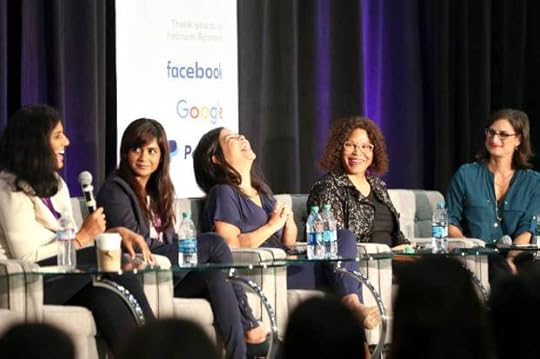Lily Salter's Blog, page 237
November 17, 2017
Leeann Tweeden reads Al Franken’s handwritten apology on “The View”

Leann Tweeden on "The View" (Credit: ABC/Lorenzo Bevilaqua)
Since broadcast personality Leeann Tweeden came out with allegations of sexual misconduct against Minnesota Democratic Senator Al Franken on Thursday, he has issued two public apologies and written a personal handwritten letter of contrition to her. Still, the senator faces calls for his resignation.
Tweeden appeared on “The View” Friday morning to tell her story, talk about the apologies and read Franken’s letter aloud. It reads:
Dear Leeann,
I want to apologize to you personally. I don’t know what was in my head when I took that picture, but that doesn’t matter. There is no excuse and I understand why you could feel violated by that photo.
I remember that rehearsal differently, but what’s important is the impact it had on you and you felt violated by my actions and for that I apologize. I have tremendous respect for your work for the USO, and I am ashamed that my actions ruined that experience for you. I am so sorry.
Sincerely,
Al Franken
In the growing library of apologies offered by powerful men to their victims, Franken’s letter is notably more genuinely contrite and thoughtful than the rest (though, admittedly, the bar for that has been set pretty low). The audience attending “The View” offered it a short round of applause.
Franken’s first apology, which he issued hours after the allegations surfaced was far less adequate. “I certainly don’t remember the rehearsal for the skit in the same way, but I send my sincerest apologies to Leeann. As to the photo, it was clearly intended to be funny but wasn’t. I shouldn’t have done it.”
Perhaps realizing its insufficiency, Franken issued a second, lengthier and more fleshed-out apology. In it, he seemingly sincerely acknowledged his wrongdoing, but still deflected at one point, claiming that he remembers the situation differently.
NEW FRANKEN STATEMENT pic.twitter.com/c3puSkK9Ts
— Sam Stein (@samstein) November 16, 2017
Tweeden says accepts the apology and will not call for Franken’s resignation, but added that she was not telling other people how to feel about whether or not Franken should stay in office.
Tweeden went on to say that “This is not about donkeys and elephants. This is about right and wrong. Right? This is about, when you don’t want somebody to put their hands on you, no is no.”
In 2006, two years before Franken would enter the Senate, Tweeden and Franken were on a USO tour together. During a rehearsal for a skit they were set to perform for the troops on it, he allegedly forcibly kissed her and stuck his tongue into her mouth. Afterward, a photographer took a picture where Franken appears to be touching her breasts while she is sleeping.
Despite Tweeden’s acceptance of Franken’s apology, the allegations above have many, including politicians, calling for his resignation. Minnesota democrats Rebecca Otto and Megan Thomas are among those who want to see Franken step down according to reports. Both Senate Majority Leader Mitch McConnell and Senate Minority Leader Chuck Schumer have expressed their support for an ethics investigation into Franken’s actions.
President Trump also weighed in, apparently oblivious to the irony. “The Al Frankenstien picture is really bad, speaks a thousand words,” he tweeted. “Where do his hands go in pictures 2, 3, 4, 5 & 6 while she sleeps? …..”
The Al Frankenstien picture is really bad, speaks a thousand words. Where do his hands go in pictures 2, 3, 4, 5 & 6 while she sleeps? ….. — Donald J. Trump (@realDonaldTrump) November 17, 2017
At this time, no less than 16 women are accusing of sexual misconduct or sexual assault, according to the Huffington Post.
This, of course, does not excuse Franken’s behavior in any way, but it is a poor attempt to make sexual harassment a partisan issue. It’s not. Trump, Moore and Franken and anyone else who treats women in such ways should be held responsible for their behavior. Party and platforms just aren’t relevant here.
Jurors can consider first-degree murder charge in Steinle trial politicized by Trump

Jose Ines Garcia Zarate, right, is led into the courtroom (Credit: AP/Michael Macor)
A first-degree murder charge is now a potential verdict jurors can rule on in the trial of a man who shot and killed Kate Steinle, which is set to begin closing arguments on Monday.
The case gained national notoriety in 2015, when then-candidate Donald Trump referenced it prominently in his speeches, in order to bolster support for his agenda of immigration crackdowns and the construction of a wall along the U.S.-Mexico border.
On July 1, 2015, Kate Steinle was walking on San Francisco’s Pier 14 with her family when she was fatally shot, according to KPIX 5. The weapon used in the shooting was stolen from the car of a U.S. Bureau of Land Management ranger only days earlier and was later recovered in the Bay near the pier. Jose Ines Garcia Zarate, a homeless Mexican citizen, was arrested an hour after the incident occurred.
Garcia Zarate, 45, was charged by prosecutors with second-degree murder, which means that the murder was deliberate yet not premeditated.
“The jury will be instructed on multiple theories of homicide,” Alex Bastian, as spokesman for the District Attorney’s Office told KPIX 5.
On Wednesday, Judge James Feng granted a request by prosecutor Diana Garcia to allow the jurors to be instructed regarding what a first-degree murder charge would mean. The charge is typically only levied for murders that are presumed to be likely premeditated and with a clear motive.
Garcia Zarate’s defense attorneys, Matt Gonzalez and Francisco Ugarte, have attempted to argue that he found the stolen gun, and that it discharged and a single bullet ricocheted off the pier which then hit Steinle in the back. The attorneys “presented expert witnesses who testified that the shooting bore the hallmarks of an unintentional discharge and that the bullet did not travel in a straight line,” KPIX 5 reported.
“We are not terribly concerned about it because nothing in the evidence supports first-degree murder,” Tamara Aparton, a spokeswoman for the public defender’s office said.
Garcia Zarate has a criminal history, and has been convicted of a drug charge and for reentering the country after he was deported, KPIX 5 reported.
The murder was repeatedly touted by disgraced former Fox News anchor, Bill O’Reilly, as the reason Trump’s immigration agenda was what the country needed. Yet Kate Steinle’s own brother, Brad Steinle, expressed dismay at how his sister’s death had become a political football wielded by the right. “If you’re going to use somebody’s name and you’re going to sensationalize the death of a beautiful young lady … Maybe you should call and talk to the family first and see what their views are … Sensationalizing it is not the route we would like to go,” Brad Steinle said in July 2015.
During political rallies and debates Trump fueled support for his campaign by railing against undocumented immigrants and sanctuary cities like San Francisco, while painting Mexicans broadly as criminals.
In an Ohio rally this past July, Trump said in a speech:
And you’ve seen the stories about some of these animals. They don’t want to use guns, because it’s too fast and it’s not painful enough. So they’ll take a young, beautiful girl, 16, 15, and others and they slice them and dice them with a knife because they want them to go through excruciating pain before they die. And these are the animals that we’ve been protecting for so long.
Why hashtags like #MeToo can spark “groundswells” of healing

As a Ph.D. candidate in the social sciences more than 20 years ago, Duana Welch, 49, had done enough research to know the consequences she’d face by reporting sexual harassment in the workplace.
“When women came forward with allegations of sexual abuse and sexual harassment, the woman was the person blamed and the woman was not believed,” she said. “I was very angry that I would pay the price for coming forward. I knew what would happen.”
Like most who’ve had similar experiences, Welch, a relationship expert in Eugene, Ore., kept quiet. She wanted to bury the inappropriate encounters initiated by men who outranked her in the workplace. Welch worried that her fledgling career would be doomed.
That was until #MeToo.
“I jumped in immediately,” she said. “I knew that this was our moment. It was the first time I became very public about abuses and inappropriate sexual conduct that I’ve experienced.”
But figuring out why Welch and the millions who have posted on social media using #MeToo isn’t as simple as chalking it up to the power of the hashtag. Rather, a complex set of psychological and sociological factors is at work. Sparked by revelations about Hollywood titan Harvey Weinstein, the mushrooming list of accused harassers and those unwilling to stay silent any longer illustrate that what’s happening with this avalanche of disclosures is more than just a show of strength in numbers.
“Admissions of being a victim are stigmatizing,” said John Pryor, a professor of psychology emeritus at Illinois State University who has studied sexual harassment for more than 30 years and is participating in a National Academy of Sciences study of sexual harassment in STEM fields — science, technology, engineering and mathematics.
“Research has shown that people with stigmatizing conditions that can be hidden often engage in what is called ‘label avoidance.’ With regard to sexual harassment, the more people who come forward and say ‘me, too,’ the less stigmatizing the label,” he said.
Gayle Pitman, a professor of psychology and women’s studies at Sacramento City College in California, said the sense she’s gotten from the #MeToo posts are “almost like a catharsis.”
“‘Finally, I can release this.’ There’s also some fear. ‘What happens now that I outed myself? What are people going to think of me and how am I going to feel now?’” she said. “There is definitely a possibility of reliving a traumatic experience or dredging up past wounds. A lot of people who have been victims of sexual violence probably have untreated PTSD [post-traumatic stress disorder] and can lie dormant for a long time until something triggers it — even a deliberate disclosure.”
The risk of triggering a traumatic experience is lessened as more women step up and validate the experience. “You think less that it’s my fault and I did something wrong and you’re blaming yourself,” said Lucia Gilbert of San Jose, Calif., a professor emerita of psychology at Santa Clara University. “It validates that you have been validated. Now there’s a validation in the culture, and that’s huge.”
Social media is at the heart of this change, experts agree.
“It connects one person’s story to a much broader story and simultaneously creates heft to your story. It’s not just me. My voice is a part of this giant groundswell,” said Amanda Lenhart, of the nonpartisan think tank New America, who has studied the internet and American life at the research institute Data & Society as well as at the Pew Research Center.
Although viewed as a critic of social media, psychology professor Jean Twenge of San Diego State University — whose book “iGen: Why Today’s Super-Connected Kids Are Growing Up Less Rebellious, More Tolerant, Less Happy — and Completely Unprepared for Adulthood — and What That Means for the Rest of Us” explores the detrimental effects of smartphones on youth — said the #MeToo trend illustrates the positives of social media.
“It allows people to band together and share their stories at lightning speed,” she said. “The workplace certainly ups the stakes for the person experiencing the sexual harassment, and it also ups the level of anger because you’re talking about someone’s livelihood. You’re talking about a career or feeding their kids. Part of the conversation is not just the Hollywood starlet but the cashier at the grocery store.”
Women may believe now is a safer time to disclose what they wouldn’t have before, said Gilbert.
“Women are speaking up, and the political environment feels different,” she said. The worldwide women’s march on Jan. 21 “was huge. Women may better understand the importance of fighting for their rights.”
She suggests that change is possible when power shifts to more women at the top in certain traditionally male-dominated industries, such as the entertainment and media arenas, politics, the sciences and tech.
“It’s much harder to change the pattern of behavior and the sense of entitlement when you don’t change the power differential,” Gilbert said.
In his 1995 study of more than 2,600 employees at a government agency with more than 8,000 employees in 37 offices nationwide, Pryor found that office norms and the workplace culture are underlying factors — which hasn’t really changed in the decades since.
“If you look at women in those offices, office by office, women were more likely to say they were sexually harassed in the offices where the men said it was tolerated,” Pryor said.
Family law attorney Cindi Graham, 53, of Amarillo, Texas, knows all about how such behavior can be tolerated.
“There’s a lawyer who says inappropriate statements, and everybody just laughs and says that’s who he is,” she said. “It’s offensive. He’ll blatantly stare at women’s breasts. He won’t go so far as grope, but he’ll leer.”
Welch said the inappropriate behavior and harassment she experienced ranged from having a supervisor expose himself to her in his office (which caused her to quickly transfer and take a pay cut) to being harassed over a two-year period by a man whose office was located in her path.
“He had a lot of power, including power over my career,” she said. “I found another way to get into the building and he came to my office and said, ‘It’s starting to feel like you’re avoiding me.’”
“In my early 20s, my story would have been an isolated event brushed away and me blamed for it,” Welch said. “I wanted to add to what I see is a really important cause. Now most people are believing us.”
Social media fires passions and builds extremist divisions

(Credit: AP Photo/Evan Vucci, File)
The people of the United States continue to learn how polarized and divided the nation has become. In one study released in late October by the Pew Research Center, Americans were found to have become increasingly partisan in their views. On issues as diverse as health care, immigration, race and sexuality, Americans today hold more extreme and more divergent views than they did a decade ago. The reason for this dramatic shift is a device owned by more than three out of every four Americans.

Americans’ political beliefs have become increasingly polarized. Pew Research Center
As social media has emerged over the last two decades, I have been studying how it changes innovation, and researching the effects of internet communications on consumer opinions and marketing. I developed netnography, one of the most widely used qualitative research techniques for understanding how people behave on social media. And I have used that method to better understand a variety of challenging problems that face not only businesses but governments and society at large.
What I have found has shaken up some of the most firmly held ideas that marketers had about consumers – such as how internet interest groups can drive online purchasing and the power of stories, utopian messages and moral lessons to connect buyers with brands and each other. In one of my latest studies, my co-authors and I debunk the idea that technology might make consumers more rational and price-conscious. Instead, we found that smartphones and web applications were increasing people’s passions while also driving them to polarizing extremes.
How social media divides people
When people express themselves through social media, they communicate collectively. Rachel Ashman, Tony Patterson and I studied sharing of images of food in an intensive three-year ethnographic and netnographic study of a variety of online and physical sites. We collected and analyzed thousands of pictures, conducted 17 personal interviews and set up a dedicated research webpage where dozens of people shared their “food porn” stories.
Our results indicate that people share images of food for a number of reasons, including the desire to nurture others with photos of home-cooked food, to express belonging to certain interest groups like vegans or paleos, or to compete about, for example, who could make the most decadent dessert. But this sharing can become competitive, pushing participants to one-up each other, sharing images of food that look less and less like what regular people eat every day.
Here is how it works. Many people start by sharing food images only with people they know well. But once they broaden out to a wider group on social media, several unexpected and startling things begin to happen. First, they find sites where they can feel comfortable expressing their opinions to a like-minded “audience.”
This audience creates a community-type feeling, expressing respect and belonging for certain kinds of messages and outrage or contempt for others. Communications innovators in social media communities often also create new language forms, such as the frustrated guys in men’s-rights-oriented social media forums on Reddit bringing new life to the 19th-century word “hypergamy,” or young people creating sophisticated emoji codes in their relationship texting.
Through language and example, community members educate one another. They reinforce each others’ thinking and communication. Members of social media communities direct raw emotions into particular interests. For example, a general fear about job security might become channeled through the feedback loops on Facebook into an interest in immigrant jobs and immigration policy.
Those feedback loops have even more sensational effects. People use social media to communicate their need for things like money, attention, security and prestige. But once those people become a part of a social media platform, our research reveals how they start to look for wider audiences. Those audiences show their interest and approval by liking, sharing and commenting. And those mechanisms drive future social media behavior.

A monstrous example of ‘food porn.’
Priyan Shailesh Parab
In our study of food image sharing, we wondered why the most popular food porn images depicted massive hamburgers that were impossible to eat, dripping with bacon grease, gummy worms and sparklers. Or super pizza that contained tacos, macaroni and cheese and fried chicken. The answer was that the algorithms that drive participation and attention-getting in social media, the addictive “gamification” aspects such as likes and shares, invariably favored the odd and unusual. When someone wanted to broaden out beyond his or her immediate social networks, one of the most effective ways to achieve mass appeal turned out to be by turning to the extreme.
Taking an existing norm in the community (massive burgers, say) and expanding upon it almost guaranteed a poster a few hundred likes, a dozen supportive comments and 15 minutes of social media glory. As each user tried to top the outrageous image of the user coming before, the extremes of food porn ratcheted toward ever more sensational towering burgers and cakes. Desire for what was once the extremes began to seem normal. And the ends separated farther from the few who remained in the middle.
The extreme state of the world
In our research, we suggested that the exact same mechanisms are at work in general society. As the Pew research revealed, American beliefs have become more partisan and more extreme. Religious beliefs are more fundamentalist. Political figures around the world are more polarized. Language is more crude.
Although the divided state of Americans is a bellwether for some of these unwelcome developments, the phenomenon seems to be global. A recent Mashable article blamed social media for fueling the horrific ethnic cleansing of the Rohingya Muslims in Myanmar, a country where Facebook viewed on mobile devices has become for many people the sole source of news. Hate speech on social media has been a major and growing problem in Europe and Africa for several years now. Around the world, social media is feeding strong partisan talk with attention. Moderation and a balanced approach to ideas and discourse seem to be fading away.
The fault for these developments lies, at least in part, in people’s consumption of technology. Even without foreign interference, our research demonstrates that social media is built for polarization and extremes. The basic engagement mechanisms of popular social media sites like Facebook drive people to think and communicate in ever more extreme ways.
 As people experience how these technological and social changes play out online, they will have to figure out how to adapt and change their behaviors – or risk becoming increasingly divided and driven to extremes.
As people experience how these technological and social changes play out online, they will have to figure out how to adapt and change their behaviors – or risk becoming increasingly divided and driven to extremes.
Robert Kozinets, Jayne and Hans Hufschmid Chair of Strategic Public Relations, University of Southern California, Annenberg School for Communication and Journalism
Pistols in preschools: As Michigan debates looser gun laws, educators are on edge

(Credit: Shutterstock)
Just days after the mass shooting at a Texas church, the Michigan Senate voted to allow people to carry guns in schools, churches, daycare centers, preschools and hospitals. The bills had been up for consideration last month when a gunman opened fire on a crowd of concertgoers in Las Vegas. Senator Arlen Meekhoff, who sponsored the legislation, called the timing “awkward.” In a year that has already seen 307 mass shootings, turns out it’s nearly always an awkward time to pass ever looser gun laws.
The legislation has parents alarmed about the safety of their children, and educators concerned about what allowing guns into schools will do to the learning environment. The showdown over what some are calling “Pistols in Preschools” is just the latest battle between Michigan schools and gun-rights advocates.
Last year, Ann Arbor Public Schools took a challenge to its gun-free zone from a gun-toting parent to the Michigan Court of Appeals and won the right to prohibit guns in their schools. Earlier this year, with that legal precedent, Kalamazoo Public Schools followed by instating their own gun-free policy in all of the buildings in their district.
So much for local control
Ironically, while Republican ideology lauds local control, these bills would strip authority from local school districts in Michigan, and force them to concede to guns in their school buildings. Meanwhile, voters who go in search of information from their representatives, including tallies of how many constituents called or wrote their senator in opposition to the bills versus how many called or wrote in support of them, are likely to be disappointed. That’s because Michigan is one of only two states that exempts the state legislature from disclosing records and communication.
If the comments on 20th District Senator, Margaret O’Brien’s Facebook page are any indication, her constituency was overwhelmingly opposed. On the same day that she voted in support of the bills, O’Brien posted information on her Facebook page about an active shooter preparedness event. The comments section contained dozens of angry replies, along with a handful of supporters. Notably, Kalamazoo, which is part of O’Brien’s district, experienced a mass shooting last year which left six people dead and two more seriously injured.
Educators on edge
While the bills must pass the GOP-controlled House and be signed into law by the governor before going into affect, Michigan educators are already feeling uneasy.
Carey Gardner is a middle-school behavior specialist in the Kalamazoo Public Schools, a district where officials have been outspoken about the need to keep guns out of schools. Gardner says she understands why people could feel like guns in schools might make people feel safer. “You have people who are faced with a shooter and they have nothing. I mean, they’re at their mercy,” she says. But she says the idea of having guns in school buildings is scary and intimidating and sends the wrong message.
“I think I could speak for everybody without even talking to anyone, we would all be on edge at some point. Because we don’t know everybody’s history,” Gardner says. “What if a student comes behind me and was to pull something, whether it was from myself or from a coworker? Or we have a parent that comes up, or parents that come up that are aggressive and agitated and frustrated? How do we know if a person’s going to be too quick to react because they’re scared?”
Gardner imagines a school environment that turns into the Wild West with shootouts in the building. With the presence of guns or even the mere wondering about who has guns, Gardner sees the inevitability of someone getting hurt.
Her concern is backed up by data. Recently NPR reported on the work of Stanford law professor John Donohue. His research on three decades of data around right-to-carry laws has found that as concealed carry rates increase, the rates of violent crimes also increase. On average, 93 people are killed by guns in the U.S. each day, and the U.S. gun homicide rate is 25 times the average of other high income countries.
Gardner says that not knowing whether or not people in her school building were carrying guns would change the culture and the climate of the building. “It’s supposed to be your safe haven, your safe place, where you learn your social skills and academically, and it changes the whole dynamic of the culture of the school.”
Wild West worries
Brandi is a special education resource room teacher in a Michigan elementary school (she asked to be identified only by her first name). Brandi says she and her coworkers already feel the tension of the possibility of an active shooter. Their first back-to-school staff meeting of the year involved a presentation about active shooter preparedness that included audio from a teacher’s phone call during the Columbine shootings. “It was sobering and difficult to hear. But I wouldn’t say it makes a difference on how we do our day-to-day activities,” she says.
That’s because teachers in her building, like everywhere else in the state, are juggling so many things already that trying to be constantly vigilant about the possibility of an active shooter is next to impossible. Brandi works in an older school building that makes it hard to comply with building security. Sure, doors are locked and people need to be buzzed into the building, but, she says, office staff members are busy and can’t guard the door, so once buzzed in, it’s mostly like an honor system for visitors to come directly to the office.
“As a staff we are expected to stop people in the hallways if they are not wearing a visitor’s pass and ask them to return to the office, but I know that I’ve felt uncomfortable doing that and have not stopped people, nor have other staff members. The teachers are supposed to cover the windows on classroom doors (so an active shooter could not see in), and keep doors locked at all times, but many do not,” Brandi says.
Teachers are already being asked to simultaneously be instructors and building security guards — jobs with completely different skill sets. Brandi says she’s never been a proponent of giving more people guns to combat other people with guns, but especially not in a school full of children. “I know I personally would not be physically stable enough to handle a gun properly, and I don’t really trust another random citizen to do the same. I would personally rather see buildings made more secure and providing teachers and classrooms with non-violent tools (e.g. for barricading doors) than adding more gunfire to a combative situation.”
Neither Brandi nor Gardner feel like they have a solution for gun violence in the country or in schools, but they both agree that having guns in schools is not the answer. “Having more people with guns to fight other people with guns sounds like a war zone, not a school,” says Brandi.
November 16, 2017
The magazine that inspired Rolling Stone

(Credit: Getty/Duane Prokop)
The 50th anniversary of Rolling Stone magazine has arrived, and not without fanfare. Joe Hagan’s biography of co-founder Jann Wenner appeared in October to stellar reviews, and earlier this month, HBO aired Alex Gibney’s documentary film about the magazine’s history. Wenner’s announcement that he was planning to sell his company’s stake in Rolling Stone also prompted a flurry of retrospective tributes.
Conceived during the Summer of Love in 1967, Rolling Stone was always a creature of the San Francisco counterculture. From the outset, the magazine touted Jefferson Airplane, the Grateful Dead and other San Francisco bands. Well before that, co-founder Ralph J. Gleason was featuring the Haight-Ashbury’s vibrant music scene in his San Francisco Chronicle column.
But Rolling Stone’s identity can also be traced to two other sources: Berkeley’s culture of dissent and Ramparts magazine, the legendary San Francisco muckraker.
The Berkeley influence was strong and direct. The magazine’s early staff writers were steeped in Berkeley’s ardent campus activism, and their views on politics, drugs and music informed the magazine’s coverage. Wenner wrote a music column for the student newspaper and covered the free speech movement for a local radio station. Even more significant for Wenner, perhaps, was the example of Gleason, who combined an impressive body of music criticism with public support for student activists. Wenner spent hours at Gleason’s Berkeley home, soaking up his insights on music and journalism.
Rolling Stone’s Berkeley roots were important, but the Ramparts influence ran even deeper. Ramparts was by no means a hippie magazine, but its rebellious spirit, flair for publicity and professional design would all leave their mark on Wenner and Gleason’s fledgling magazine.
A bomb in every issue
Founded in 1962 as a Catholic literary quarterly, Ramparts initially ran articles by Thomas Merton, John Howard Griffin and other Catholic intellectuals. But when a young Warren Hinckle became editor in 1964, he converted Ramparts into a monthly, shifted its focus to politics and hired Dugald Stermer as art director.
Hinckle also recruited Robert Scheer, a former graduate student at UC Berkeley’s Center for Chinese Studies, to write about the U.S. involvement in Vietnam. Scheer and his colleagues challenged U.S. government pronouncements about the war and routinely lampooned the mainstream media’s Vietnam coverage.
Once Hinckle, Stermer and Scheer joined forces, Ramparts achieved liftoff. It adopted a cutting-edge design, forged links to the Black Panther Party, exposed CIA activities and published the diaries of Che Guevara and staff writer Eldridge Cleaver.
A Ramparts photo-essay, “The Children of Vietnam,” persuaded Dr. Martin Luther King Jr. to speak out against the war, and the title of a Time magazine article about Ramparts, “A Bomb in Every Issue,” described the muckraker’s explosive impact. In 1966, Ramparts earned the George Polk Award for excellence in magazine journalism, and its circulation climbed to almost 250,000.

From left to right: Ramparts magazine editor Warren Hinckle, assistant managing editor Sol Stern and writer Robert Scheer.
AP Photo
Ramparts also became a seedbed for Rolling Stone. Gleason, who was a contributing editor at Ramparts, secured a job for Wenner at the magazine’s spinoff newspaper, the Sunday Ramparts. While there, Wenner picked up layout ideas from Stermer and encountered the work of Hunter S. Thompson, whose bestselling book about the Hells Angels appeared in 1967. Wenner also learned the value of showmanship from the free-spending Hinckle, who frequently echoed playwright George M. Cohan’s motto “Whatever you do, kid, always serve it with a little dressing.”
Ironically, Hinckle played an indirect role in the creation of Rolling Stone. Gleason had planned to write about the Summer of Love at Ramparts, but Hinckle ran his own cover article, “A Social History of the Hippies,” in the March 1967 issue without informing him. A furious Gleason resigned from the magazine, and Wenner lost his job when Hinckle shut down the Sunday Ramparts. That summer, the two men began working on their own publication. By alienating Gleason, laying off Wenner and demonstrating that a “radical slick” had broad appeal, Hinckle cleared the way for Rolling Stone.
Despite reaching a broad audience, Ramparts never stabilized its finances. After running through two private fortunes, it filed for bankruptcy in 1969. Hinckle left to start Scanlan’s Monthly, where he paired Thompson with illustrator Ralph Steadman to cover the Kentucky Derby; that article is now considered the first example of gonzo journalism.
The voice of its generation
Rolling Stone’s first issue appeared in November 1967, but the magazine didn’t come into its own until 1969.
In December of that year, the notorious Altamont free concert devolved into lethal chaos. Several Rolling Stone staff writers witnessed the mayhem, much of which was attributed to Hells Angels, but other media outlets missed the story. Gleason insisted that the magazine cover Altamont as if it were World War II, and its “Let It Bleed” issue landed Rolling Stone a National Magazine Award for Specialized Journalism.

Rolling Stone writer Hunter S. Thompson takes notes while listening to testimony at a trial in West Palm Beach, Flaorida in 1982.
Ray Fairall/AP Photo
Having established itself as “the voice of its generation,” Rolling Stone continued its ascent. After Scanlan’s tanked in 1971, Wenner recruited Thompson and Steadman, published their most notable work, and turned Thompson into a cultural celebrity. Wenner also hired Annie Liebovitz as the magazine’s chief photographer in 1973.
Gleason died of a heart attack in 1975, the same year Ramparts closed its doors for good. Two years later, Rolling Stone decamped for New York City. Although Rolling Stone’s reputation waxed and waned for decades, it retained its ability to break big stories. In 2008, staff writer Matt Taibbi’s political commentary earned Rolling Stone a National Magazine Award, and his 2010 takedown of Goldman Sachs rattled Wall Street. Since then, the magazine has collected two Polk Awards for stories on the U.S. occupation of Afghanistan.
Rolling Stone’s overall record is decidedly mixed. (Consider, for example, its misbegotten account of rape culture at the University of Virginia, which appeared in 2014.) But as one Ramparts staff writer observed after that magazine perished, “When you look back on it, where else would those articles appear? The Saturday Evening Post?”
 So it is with Rolling Stone: No other rock magazine could have matched its coverage of the Manson family or the Patty Hearst saga. For all its flaws, Rolling Stone accomplished a rare feat. Like Ramparts, it created a distinctive niche in the national media ecology; unlike its precursor, it maintained that niche for five decades.
So it is with Rolling Stone: No other rock magazine could have matched its coverage of the Manson family or the Patty Hearst saga. For all its flaws, Rolling Stone accomplished a rare feat. Like Ramparts, it created a distinctive niche in the national media ecology; unlike its precursor, it maintained that niche for five decades.
Peter Richardson, Coordinator, American Studies, San Francisco State University
I’m a psychologist, and this is why I believe Roy Moore’s accuser

Roy Moore (Credit: AP/Hal Yeager)
As a psychologist, for more than 20 years I have worked with individuals who have been sexually abused. And I believe Leigh Corfman, the woman who has accused Roy Moore of sexual assault. I believe adult Leigh Corfman and I believe 14-year-old Leigh Corfman as a matter of judgment based on my professional experience. When I say I believe her, it’s not a legal statement. I’m not a judge or a jury. But everything Corfman has said rings true to a pattern I’ve seen again and again, from women of different names and different ages, who have told me their stories throughout the years.
According to the Washington Post, Roy Moore was 32 and a prominent and powerful man in the community. Leigh Corfman was 14. He befriended her mother outside the courthouse and he offered to sit with her while her mother was in court for a custody hearing. She was vulnerable. He was well known in the community and respected. She would have been flattered by his attention and she would not have had the coping mechanisms and judgment an adult woman would possess.
She did not report it. The research suggests that as many as 1 in 3 women and 1 in 5 men have been sexually abused before the age of 18, though the Justice Department estimates that only 30 percent of cases get reported. In my clinical experience, very few are ever reported. I cannot tell you how many times I have sat with someone who was telling her story for the first time, often after years or decades. Even then, only in their therapist’s office after weeks or months of therapy, do they finally feel safe enough to share it.
Many women never tell their story for obvious reasons. It is clear what happens to women who do report. Leigh Corfman was a young girl from a broken home who had little to no power. She did what most victims do:
She hinted about what happened to friends who responded quite negatively to the idea of her dating someone that much older. She told one close friend more of the story and the identity of her abuser.
She reports that she “began to feel that she had done something wrong and kept it a secret for years.” Finally, she told her mother 10 years later.
She describes an adolescent life that was troubled and included a suicide attempt at age 16.
She describes an adult life with three divorces and financial problems.
Based on my experience, all of that makes her story even more believable. It is also an almost predictable outcome of untreated sexual abuse. This is an all too familiar story of an individual with little power and few coping mechanisms doing everything she can to survive a horrifying experience.
Yes, I’ve heard the false stories where a likely innocent person was accused often in the midst of a bitter custody battle. Research suggests that only 4-8 percent of reports are false and those are usually made by a parent in a custody case. In my experience, false reports are rare, while the incidence of actual sexual abuse/sexual assault is quite common. Tragically, the victims of sexual abuse are four times more likely to develop addiction, four times more likely to develop post traumatic stress disorder and three times more likely to develop depressive disorders. There are clear and significant differences between the false stories and the true. The argument that we should not believe any woman unless there is absolute proof is absurd. That argument is simply a manipulative tool used to protect abusers.
We live in a culture that loves to blame the victim. Women who report sexual abuse, sexual assault, and/or sexual harassment are perfect targets for those who would blame the victim. Even beyond all of the comments we could make about society working to protect the status quo of a male dominated culture there are psychological payoffs to blaming the victim. Blaming the victim helps us avoid that reality where horrible things can happen to any of us at almost any time. If we can blame the victim we can believe we have the power to avoid being a victim because we are smarter, wiser, more moral, and more careful. Victim blaming seems to take one of two main forms with infinite variations. The first form is denial. “She is lying.” “It did not happen.” “It did not happen like that.” This provides instant comfort because the bad thing simply did not happen. The second form can be far more subtle and involves the victim being responsible for their own victimization. This blaming involves all of the wonderful suggestions such as “why was she there,” “why didn’t she just leave,” “why didn’t she just say no.” Often these also go with the high moral judgment of “I would have never.” Blaming the victim can be very seductive. However, doing so simply perpetuates and even fuels the problem.
The problem is that we live in a male-dominated culture where way too many women and girls are the victims of sexual predators. Historically predators have largely gone unreported, faced few consequences when they were reported, and seem to roam freely with impunity throughout all levels of society. We cannot change the problem until we own the problem. We can begin by refusing to indulge in blaming the victim. We can begin by believing women when they tell us their stories.
I believe all of the Leigh Corfmans. That is a choice. That is an intentional decision. It is a matter of judgment, and most importantly, it is a matter of decency. As more women feel safe enough to tell their stories, it is deeply important that we support and encourage them. How one is treated following a traumatic event has a significant impact upon the likelihood of developing PTSD, depression, anxiety, and addiction. Telling one’s story can be a powerful beginning to the healing process. We need to do everything we can to protect these girls and women. Even if we have not been Leigh Corfman, someone we love has been. We need to create a world where it is safe to report sexual abuse, sexual assault and sexual harassment. We need to create a world where it is not safe to be an abuser and where the abused are celebrated for their courage. Would that more people in the world had the courage of Leigh Corfman.
Gene Simmons mansplains fashion, immigration, money and love

(Credit: Peter Cooper)
Gene Simmons, the lead singer of the ’70s-era bubblegum rock band Kiss, has reinvented himself in the 21st century as an icon of late capitalism.
Much like a pre-politics Donald Trump, Simmons markets himself as a “brand” whose claim to entrepreneurship rests largely on selling Kiss and his own famous name to slap on books, beers, and other products. He also, unsurprisingly, sells books about how you, too, can be rich just like him.
He stopped by “Salon Talks” to pontificate on the nature of capitalism and other topics, while promoting his book, “On Power: My Journey Through the Corridors of Power and How You Can Get More Power.”
“Love is the most powerful thing in the world. No, it’s not! Money is. Money’s the root of all evil. You’re wrong! Really, I know you’re well-intentioned,” he said, during his stream-of-consciousness opining. “Even if you’re a jackass and an evil guy, the rich create jobs.”
Simmons is well-known for his strongly held, profoundly regressive views on women. He did not hold back when visiting Salon. “Half the world’s population are the male of the species. We are visually stimulated,” Simmons argued.
Simmons indicated that he supports women who want to come to work in a “potato sack,” but he made it clear that he felt that choice, while legal, is ill-advised. Watch the video above to find out what he thinks about male vs. female sexuality.
And, watch our full “Salon Talks” conversation on Facebook.
Tune into SalonTV’s live shows, “Salon Talks” and “Salon Stage,” daily at noon ET / 9 a.m. PT and 4 p.m. ET / 1 p.m. PT, streaming live on Salon and on Facebook.
Wake up and smell the coffee pods: The “Hannity” ad boycott means nothing

Sean Hannity (Credit: Getty/Nicholas Kamm)
It has been a mind-plaiting week for critical thinkers who are in the habit of trying to understand Fox News Channel. The folks engaged in the quixotic battle to get Sean Hannity off the air must be experiencing that in addition to feeling winded, or adjusting their high-blood pressure medication.
For those of you who haven’t been keeping up with the nonsense involving Hannity, accused child molester and Alabama’s Republican candidate for the United State Senate Roy Moore, and popular hotel guest room coffee dispenser Keurig — first off, congratulations! This means you are engaging in self-care, and we love that. Good for you! If you intend to keep that up, stop reading now.
Because what I’m about to say will harsh whatever mellow you may have carved out in this insane world: No amount of “Hannity” battling will get him off of Fox’s airwaves.
I can picture a number of you shaking your heads in distress. “How can you make such an anti-#resistance statement?” you cry. “We must keep fighting.” You’re right. Team Reason needs voices of sanity and reason to continue contradicting the ravings of that neck-free menace. Just know that despite your efforts, Fox can probably get along just fine if “Hannity” loses advertisers, as long as Hannity doesn’t drive away his Keurig-crushing audience. Based on his faithful’s support of Roy Moore, it would take quite a bit for that to happen.
Here’s a summary of the situation. Last Friday, Hannity invited Moore on his radio program to answer the accusations of Leigh Corfman, a woman interviewed by The Washington Post who alleges he initiated sexual contact with her in 1979. At the time Corfman was 14 years old and Moore was 32, which, as Lorelai Gilmore might point out, makes him more than old enough to be her father.
Basically, Hannity granted Moore, a grown man who more probably than not fantasized about Marcia and Jan while “The Brady Bunch” was still in production, an uncontested forum to contradict Corfman and the claims of others who came forward. “What do you want to tell people — and I’ll just give you the microphone — about how they should view the Washington Post, these people making these charges and your denial,” Hannity generously offered at one point. “How should people see it?”
Understandably, folks who aren’t fans of grown men fondling females on the younger side of Tiger Beat’s target readership were alarmed at the Fox host’s support of Moore. Media Matters and other organizations mounted an effort to pressure advertisers to pull their support from Fox’s “Hannity,” and it was quite successful. When Keurig declared its ad-spending withdrawal on Twitter, Hannity’s horde reacted by posting films of angry people destroying the Keurigs they had already purchased by tossing them off balconies, hitting them with golf clubs or throwing them into pools.
Observers might marvel at how nice it must be to have the disposable income to afford to golf, have an in-ground pool or one’s own balcony and a premium coffeemaker.
But when Keurig’s CEO circulated an internal memo apologizing to his company’s employees about the public kerfuffle, the right-wing host, a Fox employee, accepted this mea culpa even though it wasn’t directed toward him. Keurig has not confirmed that it will resume advertising with the show. Others, including Realtor.com, said it will continue running ads on Fox’s most popular shows.
Anyway, following the company’s “Sorry-Not-Sorry,” Hannity defended Keurig, calling it the victim of “a group with a radical agenda,” before leaping across the line of scrimmage to give Moore 24 hours to “immediately and fully come up with a satisfactory explanation” for what, as of Tuesday, became “[Moore’s] inconsistencies.”
Presumably, nobody in their right mind is twisting their knickers over this about face, because we know the score: Hannity only sticks with winners, as is the way of his leader Donald Trump. Moore doesn’t seem to be winning in the court of public opinion, thus the Great Worm’s half-turn. Plus, speaking of inconsistencies, this change of tune allows Hannity to continue berating liberal Hollywood’s sexual harassers, including Harvey Weinstein and Bill Clinton (of course!) without being a demonstrable hypocrite by defending Moore.
These days, Hannity is more or less the mug of Fox News’s brand, although, like the network’s previous standard bearer Bill O’Reilly before him, Hannity is a propagandist as opposed to a journalist. Which is silly to point out because Fox viewers honestly don’t care. To them he’s the General Lee in the war for their minds, Fox’s sane-appearing alternative to Alex Jones. And as soon as the bottom drops out of Jones’ supplement dust empire, he’ll be wandering the media wastelands with Michael Savage, and Hannity probably will still be with us.
Seriously, go back to your ear plugs and “la-la-la-la-la!” land of self-care.
Still here? Yep, it is depressing to realize that at this point in Fox’s lifespan it is replenishing its audience ranks by catering to “alt-right” loons, as opposed to adopting a sensible conservative viewpoint, and know that I laughed as I typed that. Such a slant would cement Fox as part of the establishment, and isn’t the establishment the enemy?
Fox still has a reasonable conservative voice in Shepard Smith, who is doing his level best to hold back the “alt-right” wave washing over his network, and who still clings to the notion that he’s practicing some version of actual journalism. To wit: his break with the rest of Fox News’ efforts to legitimize the Uranium One conspiracy by — gasp! — citing facts, and few things anger Fox viewers as mightily as data that does not support their worldview. To them, news is a team sport.
Smith is one guy with a midday timeslot. Fox News makes its real money at night, which still makes the channel the greatest revenue generator for its parent company 21st Century Fox.
The company’s co-chairman Lachlan Murdoch recently confirmed in a call to investors, cited by CNBC, that news and sports comprise more than half of the company’s advertising revenues because both kinds of programming are more likely to be viewed live than entertainment programming. It beat earnings expectations in its recent fourth-quarter fiscal report — months after O’Reilly’s very public ouster — and only slightly missed projected revenues.
Still, for Fox News’ parent company, that translates to a two percent revenue increase during that quarter, which ended in June, to the tune $6.75 billion. A main engine of that growth is Fox News.
Months before this, a post-election Fox News had to respond in earnest to murmurs that it was losing its audience not merely to the rising competitive threats posted by Breitbart and an expanded Sinclair Broadcast Group, but to the Grim Reaper. Fox has the oldest viewership in cable news, with a median viewer age of 66. The median age of CNN’s primetime audience is 59, while MSNBC’s has ticked upward to 64.
That number is an improvement over data reported a year ago, which placed the typical Fox viewer around 68. And it means that Fox’s swerve to serve hardcore Trumpers via Hannity and conspiracy-loving nativists with Tucker Carlson seems to be working.
In October, Fox hit the milestone of being the most-watched cable news network for 190 consecutive months — 15 years and 10 months. It’s the second most-watched cable network in primetime behind ESPN, and the most watched basic-cable network in total days. And “Hannity” became October’s most-watched cable news show — up 15 percent in total viewers and 27 percent in the 25-54 demo.
In second place? “Tucker Carlson.” In October’s total viewers race, Fox programs held eight of the top 10 cable news slots; only “Last Word with Lawrence O’Donnell” (eighth place) and “The Rachel Maddow Show” (third place) cracked the ranks. Maddow, by the way, held only to the number one cable news slot during the third quarter of 2017. Even then, “Hannity” still managed to eke out the top slot in the channel’s 25-54 demographic for his network.
Hannity is maddening, truly, and his popularity and influence should aggravate anyone who values honesty and facts and fears the necrotizing effects his campaign of misinformation has on American democracy. But his high viewership ensures the current advertiser exodus is likely to only be temporary; other companies will step in, and former customers will likely follow Realtor.com’s lead and return.
The current departure is largely symbolic, understand. Unlike Hannity’s viewers, his show’s sponsors and his employer have no intention of tossing away an asset they’ve already paid for many times over.
I’ve seen the future of tech, and she’s female

Founders Panel at the Women in Product Conference, Sept 17, 2017 (Credit: Ab@alishabrook.com)
This fall, I was invited to moderate a panel for a conference put on by Women In Product, a non-profit formed to create a strong community of women builders and leaders in the tech industry.
My panel included four female founders of technology companies: Cheryl Contee of Fission Strategy, Heather Fernandez of Solv, Selina Tobaccowala of Gixo and Aarthi Ramamurthy of Lumoid.
When I walked into the main area of the San Jose Convention Center, the room had an energy you could practically taste.
Also, it was lunchtime.
It was surreal. A tech conference . . . with not a man in sight. The typical scenario, as you may have experienced yourself, is a large hall, with mostly white guys everywhere, giving you, the female attendee, the once-over — whether it’s “will she buy my product?” or “will she have a drink with me?” None of that here.
And, unlike most other conferences I’ve been to, in addition to an impressive lineup of speakers and panelists, there was also a makeup booth, a photographer offering headshots, and a lounge area with puffy white couches where women watched an entrepreneur demonstrating the power of a new product she had invented: a briefcase meets purse meets backpack. So, yeah, some girly stuff.
But there is something about bringing together a whole lot of powerful, ambitious women in one place where they can feel free from interruptions, mansplaining and awkward gender-based power dynamics.
And on the panel that I led, the speakers did not hold back. We talked about what surprised them about starting a company, the pros and cons of running a company while female, from leadership style to sexual harassment and gender bias — and ultimately as business-people what it takes to scale.
This panel took place on September 19th, 2017 and we had a full house. You can listen to our conversation here:
Women In Product was founded by a group of senior women product leaders working at a variety of Silicon Valley tech companies including Facebook, Google, Intuit, Jet.com and Trulia.
Meet the panelists:
Heather Fernandez is the founder of Solv, a marketplace for same day doctors’ appointments. Before founding Solv, she was head of business services at Trulia.
Aarthi Ramamurthy launched her company Lumoid in 2014. It’s a try-before-you-buy service for consumer electronics. Before starting her own company she was a product manager at Netflix and Microsoft — she also built an app while on her honeymoon, called Bubblegum, just saying.
Selina Tobaccowala was President and CTO at SurveyMonkey, and she co-founded Evite in 1997 and was Senior Vice President of Product & Technology at Ticketmaster. Her new company Gixo, is a workout app that offers online fitness classes.
Cheryl Contee is the CEO and co-founder of Fission Strategy, co-founder of Attentive.ly and co-founder of #YesWeCode. Attentive.ly, a social listening and marketing automation tool for nonprofits, is the first tech startup with a black female founder on board to be acquired by a NASDAQ company.
For more stories of how women rise up, subscribe to the Inflection Point podcast.




